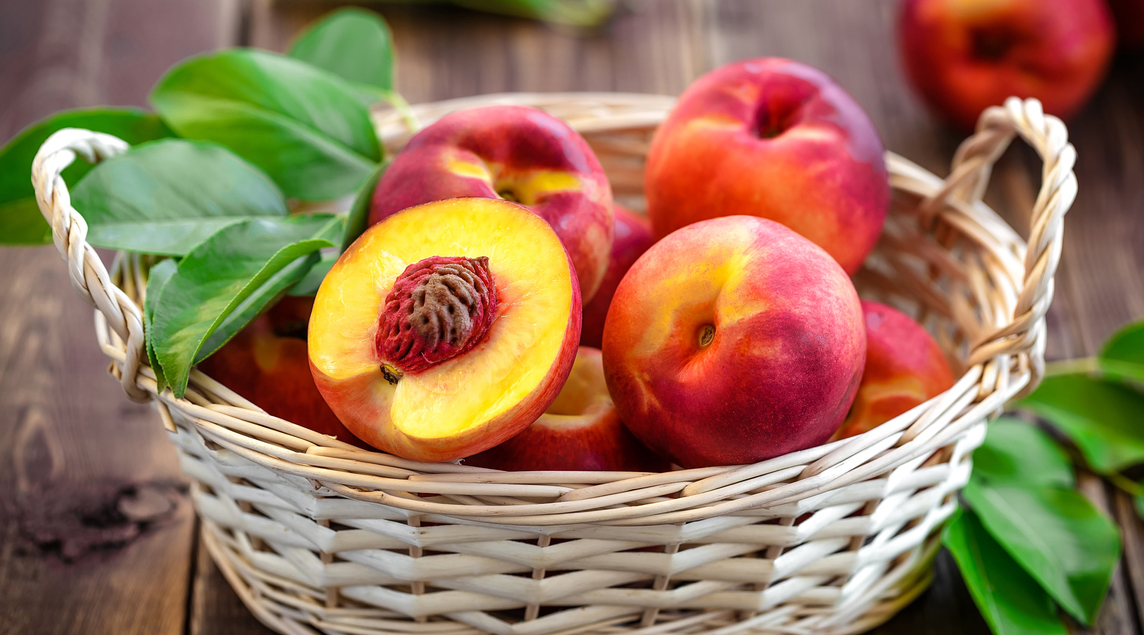Peaches

Health Power
Peaches are an excellent source of vitamins A and C. Vitamin A is an antioxidant that stabilizes free radicals associated with cancer and other diseases. It also aids proper vision in low light. Vitamin C is famous for its many benefits: healing cuts and abrasions, building connective tissue for muscles and bones, protecting immune system, preventing bruising and helping build new red blood cells. Peaches also contain other vitamins and minerals, including fiber, that aid in proper digestion and help enhance skin color.
Vitamin and Mineral Content
Vitamins – A, B1 (Thiamin), B2 (Riboflavin), B6 (Pyridoxine), C, B3 (Niacin), B9 (Folate), B5 (Pantothenic Acid), C, E and K
Minerals – Potassium, Phosphorus, Magnesium, Calcium, Iron, Selenium, Manganese, Copper and Zinc
Disease Prevention
The anti-oxidant glutathione, with vitamins A and C, correlates with preventing cancer cell development. Eating peaches reduces the risk of heart and cardiovascular disease.
How to Grow
A gorgeous addition to the backyard, peaches work miracles in summer. They grow throughout the U.S. but do best in warm summers. They thrive in healthy, well-drained soil. Pick a transplant from your nursery and put it in a fairly sunny spot. Amend the soil with plenty of compost or organic planting mix. Plant the tree deep. The first few years set the stage for the tree’s shape and size. Stake the tree after it grows taller than a foot to help it grow straight up. In spring, when growth buds appear, cut the central growth down to two feet above the ground right above the bud. Remove all the lower shoots except for the top 3-4. Later, remove any shoots under those top 3-4 branches. Before fruit bearing age, mulch widely around the trunk with compost or organic planting mix twice a year, once in March and again in May. After that, one application a year is good unless you see signs of deficiency. Keep soil moist. Water thoroughly if the soil might dry out. If soil stays too dry too long, fruiting suffers. When peaches are about cherry size, remove some, leaving 1-3 peaches per stem. If clusters form on branches, remove all but one to avoid stunting growth. When they are the size of golf balls, check the branches again and remove enough to ensure branches withstand the weight. They are ready to pick when skin softens to the touch.
Insect Control
The most serious pests are peach tree borers. Aphids and spider mites are also common. Borers enter on the lower trunk and leave sticky sawdust around their entry. Prevent by keeping the lower trunk uncovered. Kill them by sticking something in the hole such as the end of a wire coat hanger. Or cut out damaged areas until you see healthy wood. Treat with a 1:1 mix of lime-sulfur and latex paint. Aphids are a common garden pest. Control aphids by companion planting marigolds to attract their predators (hover flies or ladybugs). You can also wipe or spray off with a strong stream of water. If infestation is too great, spray an organic insecticidal soap. Red spider mites are barely visible, but their webs are easy to see. They succeed in dry conditions, so keep plant regularly sprayed with water. For a bad infestation, spray with an organic pesticide like rotenone.
Tips
The more peaches on a tree, the smaller they are. After a few growing seasons, you can determine the size that yields the best fruit to your taste. Quickly remove any shoots emerging from the roots. Also, completely remove any infested peaches or branches damaged during the previous year. This restores vigor to branches and fruit growing. Many vitamins are in the skin, so eat peaches whole.





